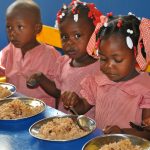 Sometimes pictures tell a thousand words and sometimes pictures are just a snapshot.
Sometimes pictures tell a thousand words and sometimes pictures are just a snapshot.
This picture of beautiful children in a cheerful classroom with full plates of food is only a snapshot.
In March of 2008, when Covenant Presbyterian signed on to partner with the community of Nan Mango,we quickly observed signs of malnutrition including the classic orange tinted hair.
So, we began to bring incredible quantities of children’s vitamins. We weighed and measured the children, finding that the majority were below the 50% percentile mark on World Health Organization charts.
We launched the Medika Mamba program which is the international gold standard for dealing with significant
malnutrition in children up to the age of five – the critical years for brain development. We learned that
most children in Haiti carry significant worm loads which prevent the full absorption of nutrients. So we
launched a twice yearly deworming program and brought hundreds of shoes as most of the worms are
transmitted through open wounds on feet. We were proud of our accomplishments.
It took Louis Rigaud, the gentle lay leader and school principal, to divert our attention from the trees
to the forest. In January of 2013, we excitedly presented Rigaud with a proposal to transform the drab,
dark school rooms into freshly painted classrooms. Rigaud smiled, nodded and said, “But our children
are hungry.” Five words. Five simple words. We sat back and listened. During the dry season, families
run through their food stocks and whatever meager funds they have saved. There is little fresh produce
at the weekly market. People are hungry all year but especially so in the dry season. Hungry children
cannot learn and our children were probably having one meal a day…. at best. Those five words, “but
our children are hungry” transformed our approach to children’s health.
 We quickly committed to a lunch program for the dry season without a clue
We quickly committed to a lunch program for the dry season without a clue
how to pay for it. But, the universe often provides unexpected opportunities and gifts.
St. Martin’s Episcopal School decided to raise enough money for us to launch the lunch
program and Covenant diverted the painting fund to the lunch program.
Others gave us money for food AND painting. So we were able to paint the school,
creating bright, happy classrooms and to start serving lunches.
A group of women, newly hired, gather at the school each morning to cook enormous pots of rice and beans
with a tasty vegetable sauce. Dozens of metal plates are placed before the children who wait patiently until
all are served and the blessing is said.
The snapshot was taken just a week ago. Happy children devouring plates of food with portion sizes
that might prove daunting to most teenaged American boys. We weighted and measured the children
and discovered that most were higher on the WHO percentile scales. Andre Melendez, an Infectious
Disease fellow who traveled with us, examined children and found a good general level of health. We
dewormed all of the children which will especially help those children with anemia.
What have we learned? Again, we learned that the Haitians truly understand their own needs and
our job is to listen and access resources for them. We learned, again, that the forest is every bit as
important as the trees. We learned what is a given in our own households that an empty stomach
cannot learn. We learned that when the need is compelling, we will somehow secure the funding. And
we have also learned that every child in the partnership, not just those in “our” community deserves
enough to eat and we are actively searching for ways to extend the lunch program into all of the
partnership schools. And we were reminded of the basic lesson of Haitian life – to have faith and hope
that things will get better. Lespwa fe viv. (Hope makes one live).
Photos and article by Lee Wilder
